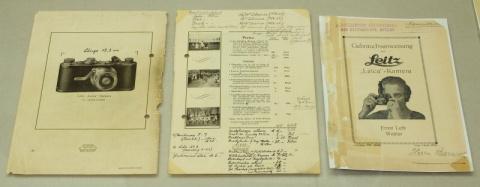The special exhibition of the Japanese Camera Museum "Camera Great Den" opens
The Japan Camera Museum will hold a special exhibition, "People who contributed to the camera's great photos and camera technology" from July 12 to October 16.In this article, we will introduce a part of the exhibition.
It contributed to the development from "discovery that light is an image", which is also said to be BC, how to record images, lenses that can obtain a clear image, and the development of easy -to -use cameras.A special exhibition focusing on "great people".
The great people begin with Johann Heinrich Schulze (Germany), which proved silver nitrate sensitivity in 1719, and Thomas Wedgewood (UK), who tried to shoot using silver chloride around 1800.
The first "camera" with a lens is "Camera of Skura", a tool for painting, such as tracing the scenery shown through the lens by hand.In 1825, Joseph Nisefall Nieps, France, was created by a combination of "Heliography", which uses the properties that a kind of asphalt is cured with light, is the oldest in the world that exists in the world.There is.
1830年ごとのカメラオブスクラ。上部のプリズムを通して写った風景を観賞またはトレースする各時代ごとに、解説パネルと関連するカメラや資料が並ぶ1790年頃の「小型カメラオブスクラ」。6×6cmの画面サイズを持ち、同館所蔵品では最も小型なカメラオブスクラという
In 1839, France's Louis Jack Made Dagre announced a silver plate photo as a "Dagure Type".The history of the camera and photography is said to have been "practical."The exposure time will be about 8 hours to 10 minutes of helioography, and will be reduced to 1-2 minutes later.
ダゲレオカメラのセット(1842年)。薬品用の箱、乾板収納箱などが含まれる。撮影後は銀板を水銀現像機(二本脚の箱)にセットし、下からアルコールランプで熱して水銀を蒸発させて現像する「フォトグラフィック ポシュ」(1860年)。感光材料の作成から撮影後の現像まで、道具一式が収まっている。乾板やロールフィルムが登場する以前は、撮影後にすぐ現像しなければならなかった技術的背景が伺えるコロジオン湿板写真法とネガ・ポジ法の完成について解説するコーナー。タルボットの完成したカロタイプ(1835年)は、1枚の原板(ネガ)から複数のポジ画像を得られる点がダゲレオタイプに対するメリットだった「ヘーア フォールディングカメラ」(1870年)。乾板になり露光時間が短くなったため、レンズキャップの代わりにシャッター機構(レンズ後部の箱)が用いられるようになる。カメラの背面に置かれているのは、12枚の乾板を入れ替えながら撮影できるホルダーRichard Reach Madox (UK) announced the gelatin dry plate method (1871) and George Eastman (USA), who acquired a patent to convert dry glass with paper (1884), commercialized the roll film.Is near.From this time, industrialization has stabilized the performance of the sensitivity.Eventually, the roll film is invented by a transparent one with the material from paper to cellulose.
紙ベースの100枚撮りロールフィルムを装填して販売した「ザ・コダック」(1888年)映画用の35mmロールフィルムを利用する小型精密カメラ「ライカ」を発明したオスカー・バルナックの直筆メモツァイス・イコンの「コンタックスS」(1949年)は、ペンタプリズムで上下左右を正しく見られる最初の一眼レフカメラ。ポロミラーを採用した「デュフレックス」(1939年)より明瞭に撮影画面を見られたSelenium's electricity was discovered in 1883 and began to be used in the field of photography in the 1930s.In 1934, Zeiss Icon's Heinz Cupenbender applied for a patent to put an exposure meter on the camera.Although he was not introduced in the Contax he led, "Contoflex" became the world's first exposure meter camera.
35mm判の二眼レフカメラ「コンタフレックス」(ツァイス・イコン。1935年)In the corner, which collected Japanese cameras on the theme of "so that everyone can enjoy photos", Miki Yoneya, an affordable camera with automatic exposure, (1961), and Miku Yoneya, who will later work on the OM series.It is introduced by the “Olympus pen”, a low-priced camera developed and called the half-size boom, and Keiji Takao, who developed the world's first mobile phone, Sharp J-SH04 (2000).
オリンパスペン(1959年)カメラ付き携帯電話の元祖「J-SH04」。写メールの始まりIf you are interested, please visit the Japanese Camera Museum because of the exhibition volume that cannot be conveyed in this magazine.
The Japan Camera Museum is located on the first basement floor of JCII Ichibancho Building, 25th Ichibancho, Chiyoda -ku, Tokyo.Admission fee is 300 yen for general, free of junior high school students and younger.Opening hours are from 10:00 to 17:00.Closed days are every Monday (the next day in the case of holidays).During the summer vacation, a workshop for parents and children is also planned.
体験用として「レンズ解像力チャート」を展示。持参のカメラで試せるパール光学製の横型コリメーター。チャートとともに、山﨑光学研究所で使われていた物JCIIで使われていたシャッターテスター。日本カメラ博物館を運営する日本カメラ財団は、かつて日本写真機光学機器検査協会(JCII)として国産カメラの輸出検査を行っていた